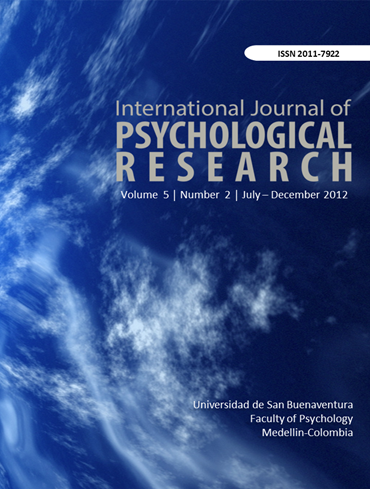How to Cite
Beltrán-Jaimes, J. O., Moreno-López, N. M., Polo-Díaz, J., Zapata- Zabala, M. E., & Acosta- Barreto, M. R. (2012). Autobiographical memory: a system functionally defined. International Journal of Psychological Research, 5(2), 108–123. https://doi.org/10.21500/20112084.742
More Citation Formats
Publication Facts
Metric
This article
Other articles
Peer reviewers
0
2.4
Reviewer profiles N/A
Author statements
Author statements
This article
Other articles
Data availability
N/A
16%
External funding
N/A
32%
Competing interests
N/A
11%
Metric
This journal
Other journals
Articles accepted
9%
33%
Days to publication
899
145
- Academic society
- University of San Buenaventura - Cali
- Publisher
- Universidad San Buenaventura - USB (Colombia)
License terms
▼
Abstract
This article seeks to define and explain autobiographical memory from a functional standpoint. For this, definitions are analyzed from cognitive and sociocultural perspectives highlighting how they converge in relation to components assumed as constituent of autobiographical memory and tasks attributed to it. A theoretical model about its functioning is reviewed and allows us to understand how the memory systems that constitute it interacting with process control and cultural patterns to generate autobiographical memories essential to maintain a consistent image of the individual and a moderately accurate record of the experiences. Its functions are described: self-definition, social interaction and self-regulation. It raises that autobiographical memories are multimodal, are distributed among memory systems and executive processes, and are mediated by sociocultural contexts
References
Alea, N. & Bluck, S. (2007). I’ll keep you in mind: The intimacy function of autobiographical memory. Applied Cognitive Psychology, 21(8), 1091–1111.
Ames, D. L. & Fiske, S. T. (2010). Cultural neuroscience.Asian Journal of Social Psychology, 13(2), 72–82.
Baddeley, A. (1988). But what the hell is it for? In. Gruneberg,M, Morris, P. & Skyes, R. (Eds.), Practical aspect of memory: Current research and issues (pp. 3–18). Chichester, UK: Wiley.
Baddeley, A. (2012). Working memory: theories, models, and controversies.Annual review of psychology, 63, 1–29.
Baddeley, A. D., Aggleton, J. A. & Conway, M. A. (2002). Episodic Memory. Oxford: Oxford University Press.
Berntsen, D. & Bohn, A. (2010). Remembering and forecasting: The relation between autobiographical memory and episodic future thinking. Memory and Cognition, 38(3), 265–278.
Berntsen, D. & Jacobsen, A. S. (2008).Involuntary (spontaneous) mental time travel into the past and future.Consciousness and Cognition, 17(4), 1093–1104.
Berntsen, D. & Rubin, D. C. (2004). Cultural life scripts structure recall from autobiographical memory. Memory and Cognition, 32(3), 427–442.
Bluck, S. (2003). Autobiographical memory: exploring its functions in everyday life. Memory, 11(2), 113–23.
Bluck, S. (2009).Introduction Baddeley Revisited: The Functional Approach to Autobiographical Memory. Applied Cognitive Psychology, 23, 1050–1058.
Ames, D. L. & Fiske, S. T. (2010). Cultural neuroscience.Asian Journal of Social Psychology, 13(2), 72–82.
Baddeley, A. (1988). But what the hell is it for? In. Gruneberg,M, Morris, P. & Skyes, R. (Eds.), Practical aspect of memory: Current research and issues (pp. 3–18). Chichester, UK: Wiley.
Baddeley, A. (2012). Working memory: theories, models, and controversies.Annual review of psychology, 63, 1–29.
Baddeley, A. D., Aggleton, J. A. & Conway, M. A. (2002). Episodic Memory. Oxford: Oxford University Press.
Berntsen, D. & Bohn, A. (2010). Remembering and forecasting: The relation between autobiographical memory and episodic future thinking. Memory and Cognition, 38(3), 265–278.
Berntsen, D. & Jacobsen, A. S. (2008).Involuntary (spontaneous) mental time travel into the past and future.Consciousness and Cognition, 17(4), 1093–1104.
Berntsen, D. & Rubin, D. C. (2004). Cultural life scripts structure recall from autobiographical memory. Memory and Cognition, 32(3), 427–442.
Bluck, S. (2003). Autobiographical memory: exploring its functions in everyday life. Memory, 11(2), 113–23.
Bluck, S. (2009).Introduction Baddeley Revisited: The Functional Approach to Autobiographical Memory. Applied Cognitive Psychology, 23, 1050–1058.


































